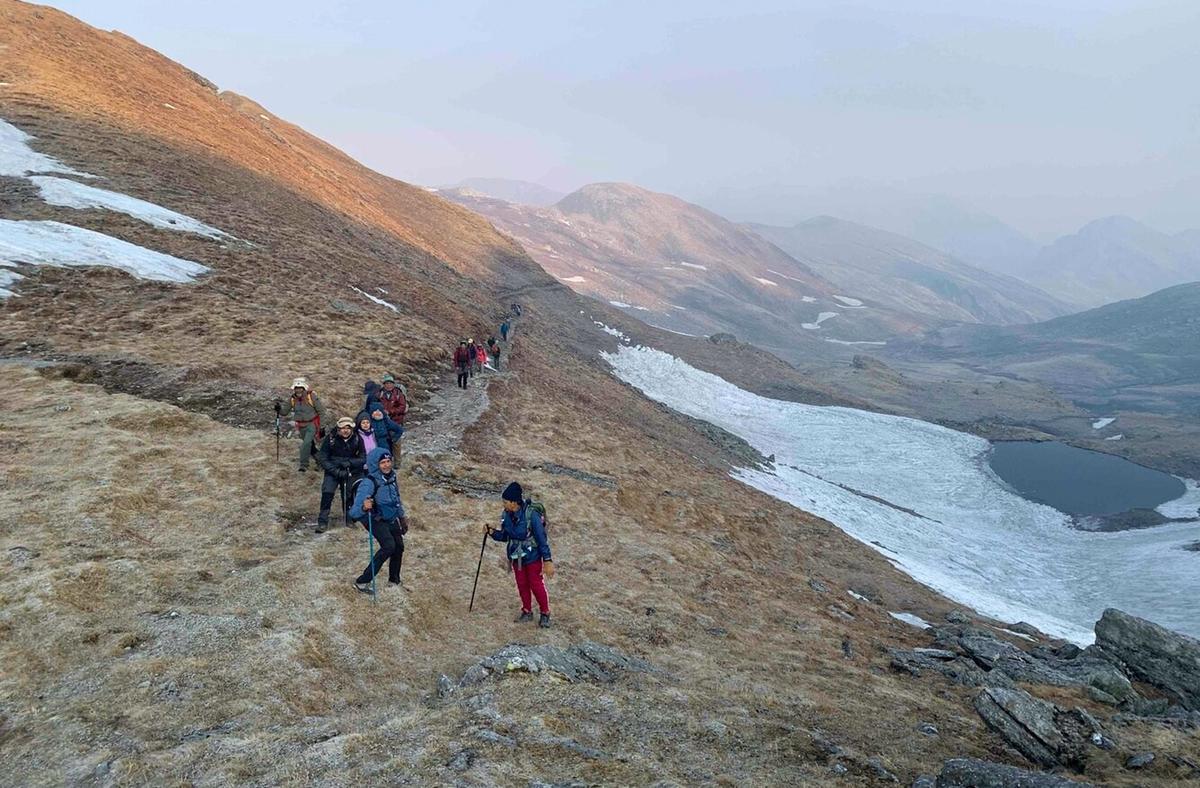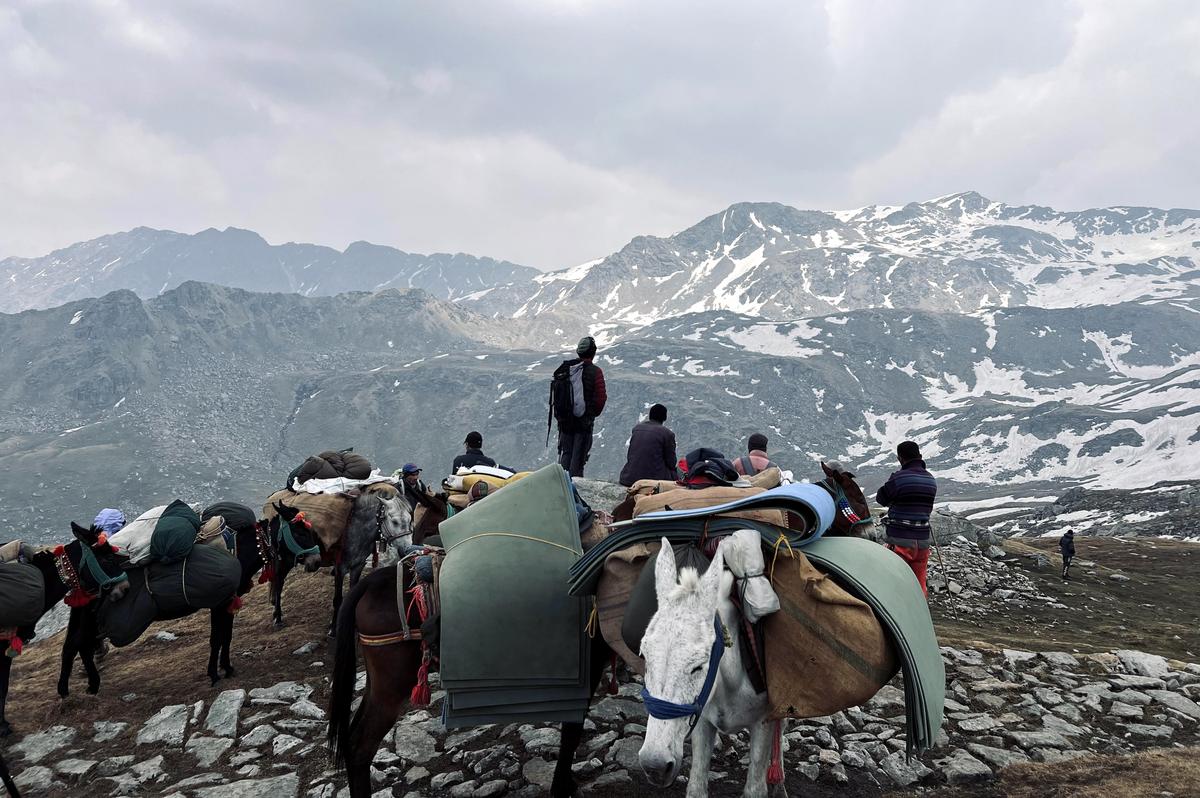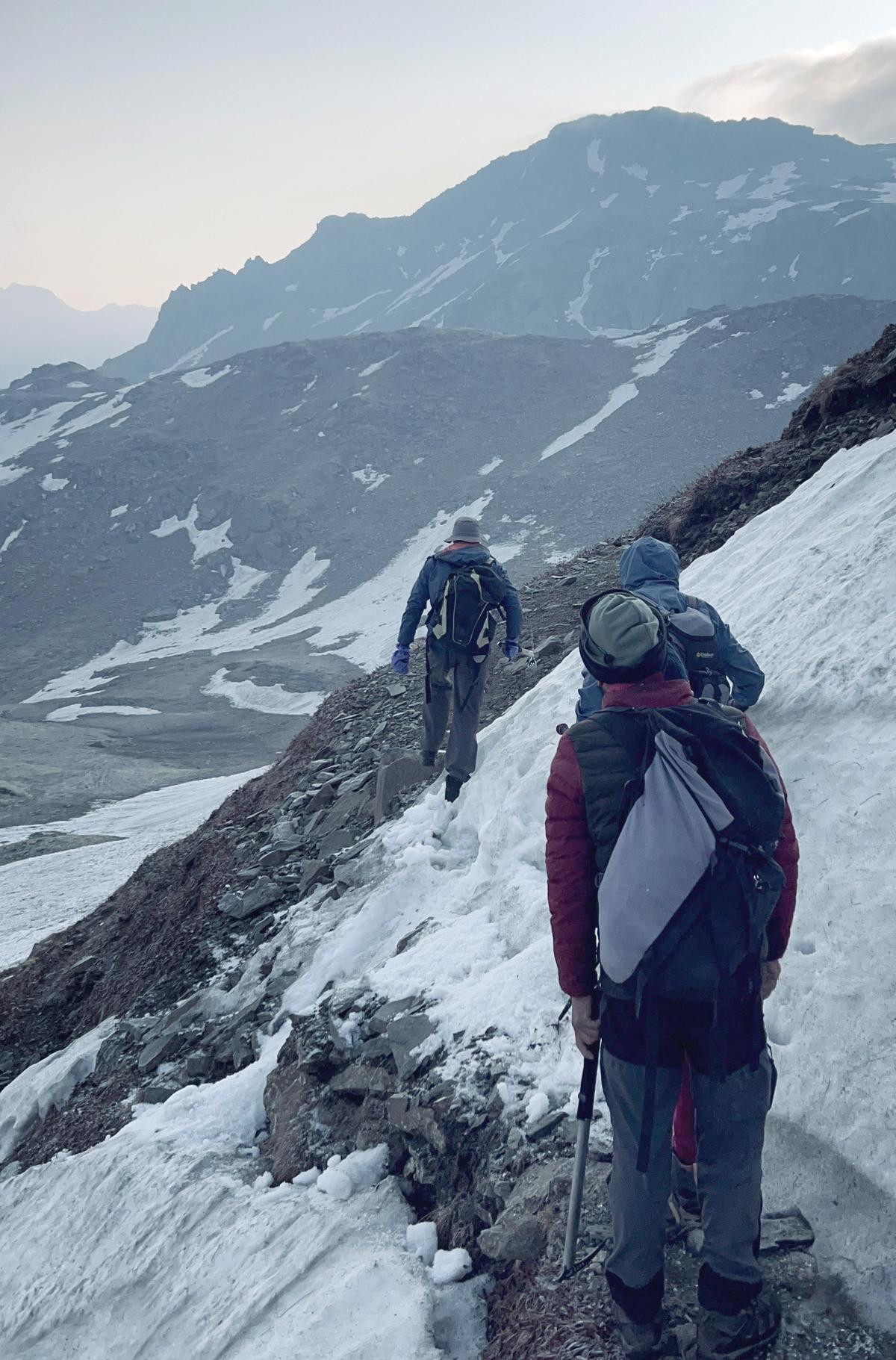“As the evening got darker and we were all huddling against a boulder, our trek group leader, S. Sudhakar, told us, ‘This is the night of survival. Nobody is coming to help you. As soon as we see some light in the morning, we will go down.’ This motivated many of us to make it through the night,” said Sheena Lakshmi, a 47-year-old woman, remembering the events of June 3, when a 22-member trekking group from Bengaluru got caught in a blizzard while descending from the Sahastra Tal summit in Uttarakhand.
“While I knew that death was not an option for me as I had to go back to my daughter and mother, I had one complaint the whole night. Even with four layers of clothing, including thermals and jacket, and a hat and a muffler, I was not warm enough,” she recalled. According to some surviving trekkers, the temperature touched anywhere between –8 degrees to –10 degrees Celsius that evening.
Nine members of their group died between June 3 and 4 due to hypothermia, as they were forced to benight near a boulder for their safety after a whiteout and a snow blizzard a few hours earlier made it impossible for them to trek down. Sudhakar’s wife, Asha Sudhakar, was one among the dead. Despite suffering a personal tragedy, group members remember how Sudhakar maintained a level head and took care of everyone else throughout the night.
“On one side, you know what you are going through, and on the other, there were young people who had families and their children waiting for them (and I had to keep them alive). Irrespective of what had happened, I had to focus on what was best for the team,” Sudhakar said in his house in Jakkur in North Bengaluru.
Sudhakar, who is in his mid-60s, and his wife Asha, who was in her early 70s, had met in the mountains decades ago. The duo had trekked several routes, including the Himalayas, over the years. Their home is a testament to their love for mountaineering and their fitness. While many pieces of art and photographs of the Himalayas adorn the walls, Asha’s swimming medals are displayed in one part of the living room. When they embarked on their recent trip to the mountains in Uttarakhand in the last week of May, they had not imagined that it would be their last adventure together.

Members of the trekking team during the expedition.
| Photo Credit:
special arrangement
Two fateful days
Sitting next to his wife’s photograph, Sudhakar, who is also the joint secretary of the Karnataka Mountaineering Association (KMA), which had organised the trek, began to narrate the events of those two fateful days.
“Everything was going beautifully up until that point,” he said. The tragedy occurred on the fifth day of their schedule. By then, the trekkers had developed a sense of camaraderie among them. Most of them had met before on similar treks.
After meeting in Dehradun on May 28, the group trekked from Sila to Base Camp between May 30 and June 2. On June 3, they had to ascend 4,610 metres (over 15,000 feet) to reach the summit. It was the D-Day.
“We had briefing sessions every day, and we regularly checked parameters like oxygen levels and heartbeat of all the trekkers. In fact, on the day of our ascent to Sahastra Tal, we had to send a trekker back to Kush Kalyan (below the base camp) as she had developed a headache. Her husband volunteered to go back with her, and we also spared a guide and a mule for them. The remaining 20 of us, along with our three guides, began our trek around 5.30 a.m.”

Members of the trekking team during the expedition.
| Photo Credit:
special arrangement
Thunder from a distance
The group reportedly encountered a few minor difficulties on the way as they had to manoeuvre snow patches on the mountain, which slowed them down a bit. On the way, five people stayed back as they felt they would slow down the entire team. The rest of the group, after reaching the summit around 1.15 p.m., started their descent around 1.30 p.m. A little down the road, they could hear thunder from a distance, and sleet had begun to fall.
But the sight of snow did not cause any alarm immediately. “It was my first actual snowfall experience, and all of us were excited. Nobody had anticipated anything like this at that time.,” said Sheena. She lost both of her tent mates, Padmini Hegde and Sindhu Vakekalam, in the tragedy.
A few minutes later, when sleet turned into snow pebbles and the wind started picking up, worry set in, and the trekkers started to move at a faster pace. “When the wind started picking up, something inside me made me nervous. The snow kept getting heavier as we walked,” Sheena said.
Eventually, the members who had stayed back also joined the group. A few people went ahead and started making their way into the snow patches for others to follow. By 4.30 p.m., the group had reached a difficult snow patch (under the circumstances), and by then, the weather had taken a turn for the worse. The group walking in a line was suddenly hit by a blizzard which overturned their jackets and ponchos while blowing away their sticks, goggles and hats. There was also a whiteout soon, and the trekkers said they lost all visibility at that point. Sudhakar said it was at this point that he decided to benight.
“I had never seen this kind of weather in my 35 years of trekking experience. There were some four to five inches of snow, but it was the wind and the whiteout that upturned our plans,” he said.
The harrowing hours
By around 6 p.m., all 20 trekkers and the guides were together. It was decided to take shelter for the night under a rock — around a metre tall and a metre and a half wide — near a point called Khukli Top Base (Khukli Top was a ridge that had to be crossed for the trekkers to get to base camp). Some trekkers had temporarily sought shelter under a smaller rock, which was approximately 50 to 100 metres away. As the group tried to make its way to the bigger rock for shelter, two lives, Padmini Hegde (34), the youngest member of the group and Anita Rangappa (60), were lost between 6 and 7 p.m.
Asha, who Sudhakar said had a frail body (but full of grit and determination), also collapsed during this walk. “Somehow, she had collapsed. But I knew that I had to take care of the entire team, not just one person. So, we put her near the boulder and covered her in warm clothes. I knew at the time that her condition was bad,” he recalled. Asha did not make it to the next morning.
“When you are seeing people you are close to, especially Asha ma’am, who was like a mentor to me, pass away, it hits you hard,” said Anil Bhatta (52), another survivor. He shared his poncho with two others throughout the night to stay warm. He said by 11.30 p.m., the weather conditions were better and recalled pulling his phone with great difficulty to check the time. “I checked my phone a few more times that night as I kept reminding myself that I only had to make it through a few hours until I could get to the camp. By 3 a.m., wind picked up again,” he said.

Members of the trekking team during the expedition.
| Photo Credit:
special arrangement
The trekkers sat between each other, slept on each other’s laps, rubbed each other’s hands and shared their warm clothing, even when they could not make out who the person sitting next to them was. “From 11 p.m. to 3 a.m., my body kept involuntarily shivering every 2 minutes. I put my hands into my poncho and collapsed because of exhaustion. My mind had blacked out, and I had no thought, emotion or fear. Just a void,” recalled Vinay M.K. (47), another survivor.
On the other hand, Sudhakar and a few others took it upon themselves to keep the group members active till the morning. “We asked people to huddle and share warm clothing. We asked them to keep their fingers and toes moving. We woke them up, talked to them and cheered them up throughout the night. Everyone was helping each other,” Sudhakar said.
Despite the team’s best efforts, there were two more deaths between 7 p.m. and 4 a.m. While the more active members of the group knew of it, some of them did not realise it until the next morning. “When I woke up in the morning, I saw that my tent mate (Sindhu), whom I remembered by her blue raincoat, had slouched down into a ball. I cried out to someone to check up on her, only to realise that she had passed away,” Sheena sadly recalled.
As the first signs of light started to appear on June 4, Sudhakar, two guides and a few other survivors began their descent around 4.30 a.m. to pass on the SOS message to the District Disaster Management (DDM) authorities of Uttarkashi and the secretary of KMA, while some others stayed back to take care of those who were not fit to walk. Over the next few hours, five more people, including a couple who shared the same birthday (Vinayak Mungurwadi and Sujatha Mungurwadi), had also breathed their last, taking the death toll to nine.
The survivors reported that during those two days, their emotions were quite numb for reasons they could not really decode. “Whoever we suspected had passed away, we would check for their pulse, and if they were gone, then there was no bereaving or crying or panic. We just had to help whoever had survived,” said Sheena. However, the survivors also said it seemed like whoever had passed away did not suffer any pain as most of them just dozed off into a sleep and did not wake up.
Eight members had reached the base camp by evening while Sheena and a husband-and-wife duo, Soumya Kanale and Vivek Sridhar, had to spend another night near the same rock as Sheena and Soumya were not in a condition to walk. Even those who had made it to the base said the descent, which should have ideally taken 1.5 hours, took over 3 hours due to exhaustion.
The second night, the guides had managed to take tents, mats, sleeping bags, hot beverages and food to the point where the three were staying (along with a guide). “They brought supplies for eight people as when they had departed, there were eight of us alive. But by the time they came back, it was only the three of us,” Sheena said. The trio were there at the same place until Indian Air Force flights airlifted them on June 5.
“Now, when I think about sleeping there with the bodies of our loved ones, I don’t know how we did it. I think all of us were very strong, but at the same time, looked out for each other and took care of each other,” Sheena added.
The aftermath
With the intervention of the governments of Karnataka and Uttarakhand, all 13 survivors came home safely. But once they were home, survivors’ guilt started troubling them. “It was hard to leave teammates behind, but when we were given instructions to move, we had to move. But the questions start haunting you the next day. Could I have done something to save someone? Did I leave my teammates there?” Anil said. He said he was considering getting professional help for the same.
Sheena also reported that the images of those fateful days started coming back to her in the second week after the incident and that she felt a sudden rush of sadness sometimes. While numerous reports came out presenting different versions of those days, survivors asserted that they were neither lost nor were without guides during the trek.
“Staying at that altitude at that time is completely different, and decision-making is critical. We know a lot of things theoretically, but at that moment when the situation hits you, a lot of things change. That, people who were not there at the time will never understand,” Sudhakar mentioned, speaking about the difficult decisions he had to make in those two days.
All 22 members of the group were experienced trekkers but said they had never experienced a weather event like that before. Every member in the group knew one another and said even in the face of the tragedy, there was a familial bonding.
Vinay put it this way: The more I thought and spoke about it the more I became convinced that I came back to tell the tale. A tale of camaraderie and endurance. Of hope, acceptance, sacrifice and, above all, pure valour. A tale to be told to the world on how the trekkers fought against the odds. A tale etched on life for those who came back with scarred faces, broken hearts and numb limbs.
Back to mountains?
Will the survivors, for most of whom mountaineering is a passion and an almost spiritual experience, go back to the mountains after the tragedy? The answers differed.
“At this point, I am undecided about going back. I must recover and come to terms with what happened and personally recalibrate. I must also consider the views of my family members, who told me now that they would not let me climb any hills other than the small hillock in Lalbagh. But I do not know. I might go to the mountains again,” said Anil.
Sheena said although she had decided that she would not climb the mountains again during those days, she too might go back one day. “For me, climbing is like meditation. Last week, I had a strong desire to go back to the mountains,” she remarked.
As for Sudhakar, it is a definite yes. “To be frank, I intend to go to the same place again. I wish to make a small memorial there for all the people who lost their lives. It will take me some time, but I will go back,” he said.




